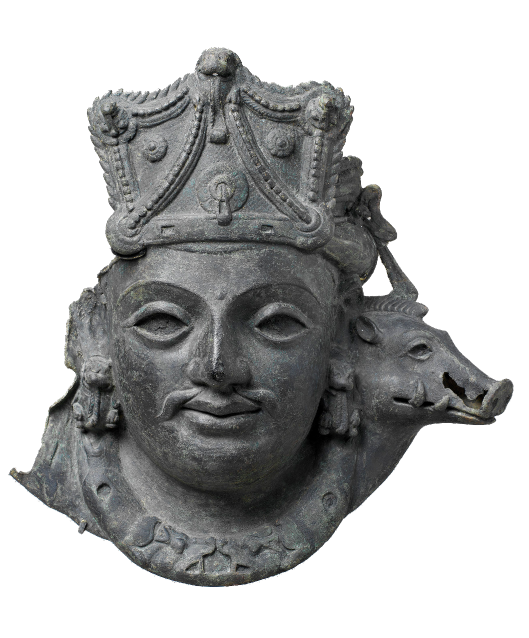ARTICLE
Zafar Takiya
An Indian sword, dagger or staff with a crutch handle, the zafar takiya was used by elite and royalty of the subcontinent between at least the sixteenth and nineteenth centuries, as well as by Sufi dervishes in the region. Though appearing in many forms and designs, the zafar takiya is characterised by a hilt shaped to serve as a hand- or arm-rest while seated or standing, depending on its length.
Terminology
Derived from the Farsi takiya-i-zafar (literally ‘cushion of victory’, from the Arabic takya, ‘support’), the term ‘zafar takiya’ appears in Indian historical sources from the Mughal period onward. The weapon is sometimes also called salapa, an Indic term of uncertain origin. Both terms generally refer to the courtly sword with a crutch handle, though ‘zafar takiya’ is also used to denote the handle alone as a separate design element. The sacred crutch carried by Sufi dervishes — which shares a similar design and function, and commonly referred to as the ‘fakir’s crutch’ by collectors — is typically also called zafar takiya; another term for this is bairagi in various Indian languages, likely derived from the Sanskrit vairagi, which broadly denotes ascetics or renunciants of various religious backgrounds. Zafar takiyas with narrow swordstick-type blades were known as gupti in several Indian languages (from the Sanskrit gupti, meaning ‘concealed’ or ‘guarded’).
Historical background
Historical sources and artworks from the sixteenth century onward attest to the use of the zafar takiya, though its origins are unclear. The earliest of the extant specimens now housed in museums and private collections date to the sixteenth century. The weapon was used by rulers and elite men in several medieval Indian kingdoms, including the Mughal and Maratha empires, the states of Rajputana, the Deccan Sultanates, and the Sikh kingdom. One belonging to the Mughal emperor Jahangir (r. 1605–27) is housed at the Victoria & Albert Museum in London. The weapon was typically part of male formal attire at court sessions; the king would often appear with the zafar takiya as a prop both for comfort and to signal power and authority, and the attending courtiers and members of nobility would rest their arms on their own zafar takiyas while seated, as frequently seen in miniature paintings from these kingdoms. It could also be placed under the armpit for support. At least one eighteenth-century Pahadi miniature of a procession scene shows a palanquin-bearer carrying a long staff with a zafar takiya handle, though it is unclear whether it was widely used in this way in other courts.
The origins of the ascetic’s zafar takiya are also unclear, though the implement is described in medieval texts and depicted in artworks among various other objects commonly carried by Sufi holy men, such as the kashkul. Dervishes were prohibited from carrying weapons, but the zafar takiya allowed them to conceal swords for their safety as they wandered, often alone, from place to place. The ascetic’s zafar takiya appears, for example, in the seventeenth-century Mughal miniature painting Portrait of Mian Mir and Mulla Shah, attributed to Muhammad Musa, and the painting Mulla Shah Badakshi Sits in Meditation, from the same period; these paintings show smaller zafar takiyas, probably concealing short, thin daggers. The object served as a hand rest, as in the former painting, and could also support both arms while folded; longer zafar takiyas could support the chin or forehead during long hours of meditation.
Design and decoration
Most zafar takiyas — both the courtly and ascetic type — were designed as a blade concealed in a sheath with a flat tip so that they could stand stably on the ground. Some, especially courtly specimens, take the form of a typical sword with a wide, flat tapered blade; at least one extant specimen features a wider sosan-patta (Hindustani, ‘lily leaf’) blade. Others feature a thin, double-edged stiletto blade with a square or diamond cross-section; these are often seen in the Sufi crutch. In swordstick-type zafar takiyas, the sheath of the blade is often screwed into the pommel. Some courtly zafar takiyas did not include blades at all; these functioned more as ceremonial staffs or maces.
There are two common types of zafar takiya handles. One design, seen both in courtly and ascetic zafar takiyas, is a simple crescent shaped bar perpendicular to the blade, thicker in the middle and tapering towards the ends, with the two ends usually shaped as the heads of animals, often parrots, tigers, ibexes, or chimeric makaras. The bar may at times be quite straight at the middle, forming a T-shape with the blade, with its ends curling sharply upwards and a pair of metal loops attached to its underside, on either side of the blade — as seen in a nineteenth-century steel specimen at the Metropolitan Museum of Art, New York.
The other common design, which typically appears only in the courtly zafar takiya, is a bar perpendicular to the hilt that curves slightly upward at one end and downward at the other to connect to a knuckle guard along the hilt. Less common zafar takiya designs include a C-shaped handle with an elongated, recurved top bar that ends in a knob shaped as an animal’s head; and a handle shaped as a horizontal Arabic numeral eight culminating in a lotus-bud knob. One rare specimen, at the Salar Jung Museum, Hyderabad features a handle shaped to resemble the name Ali written in Nastaliq script.
Extant specimens of courtly zafar takiyas are made of a range of materials including gilt silver, welded Damascus steel, ivory, bronze or jade. Metal specimens are often embellished with koftgari on both the blade and the hilt — a type of damascening commonly used on medieval Indian weapons, featuring geometric and natural motifs such as feathers, acanthus leaves, flowers or vines. They are also sometimes inset with gemstones. In some instances, courtly zafar takiya handles made in the Indian subcontinent were attached to imported blades; one extant specimen features the characteristic wavy blade of an Indonesian kris dagger and another Mughal specimen features a blade from North-Rhine Westphalia in present-day Germany.
The zafar takiyas of the Sufi dervishes were typically made of wood or metals such as steel, bronze or copper, and were usually less ornate. Medieval paintings often show dervishes carrying a simple T-shaped crutch with stylised pommels. At least one extant specimen dated to the seventeenth or early eighteenth century is embellished all over with sadeli mosaic work — however, it may have been an ascetic-style crutch used in court, rather than one used by a dervish. Some specimens feature a distinctive design where the pommel takes the form of a closed fist holding one end of an antelope horn, whose length serves as the main grip or hand rest, with the other end shaped as a snake with a tiger’s head.
Bibliography
Egerton, Wilbraham Egerton. A Description of Indian and Oriental Armour. London: W. H. Allen and Co., Limited, 1896.
Haider, Najat Navina, and Courtney Ann Stewart. Treasures from India: Jewels from the Al-Thani Collection. New York: Metropolitan Museum of Art. 2014.
Kurochkin, Aleksey J. “Fakir’s Crutch.” Journal of Historical Weapons Research, no. 3 (2020). https://journal.kunstkamera.ru/en/archive/2020_03/kurochkin_a_j_fakir_s_crutch.
Pant, G. N. Studies in Indian Weapons and Warfare. New Delhi: Army Educational Stores, 1970.
Paul, Jaiwant E. Arms and Armour: Traditional Weapons of India. New Delhi: Roli Books, 2005
Salar Jung Museum, Hyderabad. “Procession Scene.” Google Arts & Culture. Accessed October 24, 2025, https://artsandculture.google.com/asset/procession-scene/zQG74KpsqxQWMg?hl=en.
Singh, Runjeet. Arms & Armour from the East. Self-published, Taylor Bloxham Ltd.: 2015. https://issuu.com/runjeetsingh/docs/runjeet_singh_-_arms___armour_from_.
Singh, Runjeet. Treasures from Asian Armories. Self-published: 2019. Accessed December 18, 2023. https://cdn.prod.website-files.com/68a5a30eeb65752c2c3f8566/68af2994fb6f6051c42eea43_treasures_from_asian_armories.pdf.
Skelton, Robert, ed. The Indian Heritage: Court Life & Arts Under Mughal Rule. London: Faber and Faber, 1982.
Stone, Cameron George. A Glossary of the Construction, Decoration and Use of Arms and Armour in All Countries and in All Times. New York: Jack Brussel, 1961.






